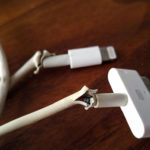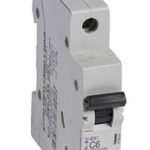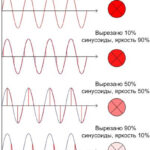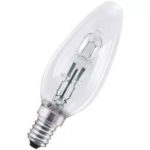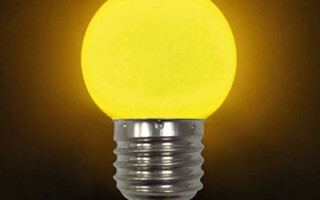LED lighting devices are rapidly conquering the lighting equipment market for a clear advantage. Traditional light sources have no competitive preferences. But some owners of LED lamps have encountered an unpleasant situation - after opening the contacts of the switch, the device continues to glow not at full intensity or blink. This phenomenon can and should be fought, but first of all it is necessary to find out the cause.
Content
Why LED lamps can glow dimly after being turned off
At the heart of this unpleasant situation lies the ability of LEDs to glow even at a small current (though not at full glow).But the reasons for the occurrence of this current when the switch is open can be different.
Switch with LED indicator
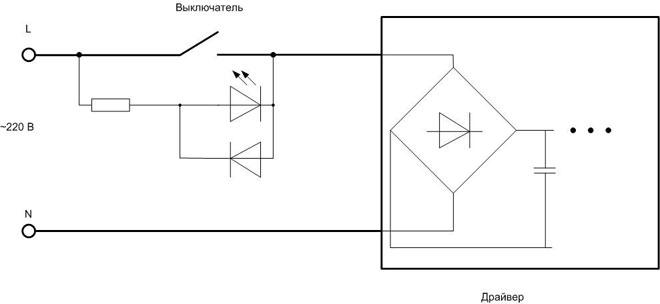
In everyday life, switches with LED (or halogen) backlit. When used in conjunction with incandescent lamps, such switching elements do not create problems. The small current required to ignite the backlight is limited by a resistor, and it is clearly not enough to light a traditional lamp. Another thing is LED lamps. A small current can charge the input capacitor of the electronic driver. By accumulating charge and periodically discharging through the circuit, the capacitor can cause the LEDs to flash. If the lamp uses a circuit with a ballast resistor, there may be enough current to dim the LED.
Electrical wiring fault
Lighting when the switch is open can be caused by leakage currents in the network. As insulation ages, leaks can appear anywhere and cause voltage to appear at unexpected points. In this case, small currents arise, but they can cause a weak glow of LED illuminators.
Influence of capacitive couplings
In some cases, leakage occurs through capacitive coupling. One plate of the capacitor forms a phase or neutral wire. The other is a wire laid nearby, a grounded metal element (fitting), a damp wall or ceiling, etc. With the help of a megohmmeter, this problem is difficult to detect - it works with a constant voltage.
Capacitive coupling between the phase and neutral conductors can create a problem if there is a small voltage present on the neutral conductor. This is a common phenomenon, its cause is the asymmetry of the loads on the phase wires.Then, when the phase wire is broken by a switch, a small current will appear through the capacitance between the wiring of one lamp, which will be enough to ignite the LED.
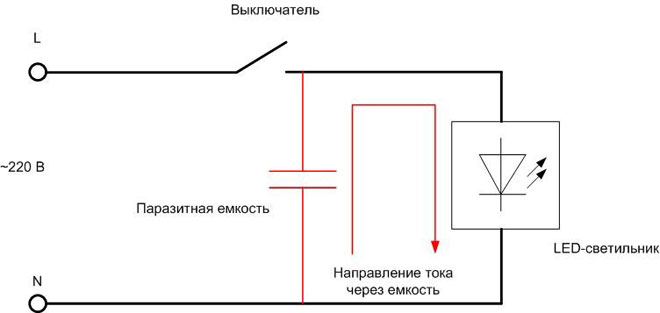
There may also be a problem of interference. If parallel to the phase or neutral wire, another conductor loaded with a powerful load is laid nearby and for a long distance, then the current flowing through it creates a noticeable electromagnetic field. It can induce sufficient current in lines located nearby.
Poor quality led bulb
If inexpensive light bulbs from unknown manufacturers from Southeast Asia are used for lighting, then poor workmanship can also be the cause of unauthorized glow:
- poor quality insulation causes leaks inside the luminaire itself;
- to stabilize the operating current of the LED, cheap technical solutions are used, which can cause problems.
It is impossible to predict the manufacturer's fantasy in this direction. With a single purchase, such a device is easy to identify during the initial check. If a defect is found, you can refuse the purchase. But this problem can be missed when buying a large batch of fixtures (for example, for an organization) - it is impossible to check all the fixtures. Yes, and the defect may not manifest itself immediately.
Incorrect connection of the LED lamp
The switching circuit of the luminaire may be assembled incorrectly - when turned off, it may not open the phase conductor, but the neutral one. With a small leakage or in the presence of capacitive coupling in the circuit, conditions will be created for the flow of current through the light emitting elements. This situation is also dangerous because even when the switch is open, the luminaire elements will be under mains voltage.This creates a real risk of electric shock when repairing or servicing the lighting system.
How bad is it that the LED lamp stays on after being turned off?
Unauthorized illumination of a lighting device creates a number of problems:
- Flashing or a dim glow can be annoying. Especially if the LED lamp is used to illuminate bedrooms, hotel rooms, etc.
- This mode significantly reduces the resource of an expensive device. Constant glow, albeit in a weakened form, reduces the service life by half or more.
- Dim light caused by leaks indicates wiring insulation problems. And it is necessary to pay attention to this and take measures to prevent the development of a malfunction.
Therefore, if a problem occurs, you should find out the cause of the glow as soon as possible and eliminate it as quickly as possible.
How to fix the problem
The method of troubleshooting depends on its origin. In order of the reasons listed in the first part of the review:
- The easiest way to eliminate the glow caused by the flow of current through the backlight resistor switch, is chain removal. If this is unacceptable, there is another way - to connect a resistor with a resistance of several tens of kilo-ohms and a power of at least 2 W in parallel with the lamp. It will take some of the current back to itself and prevent the capacitor from charging.
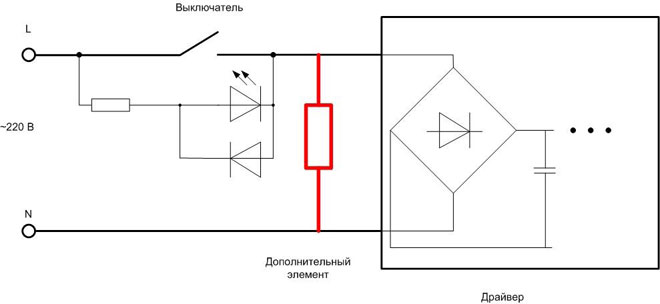
It is even better to connect a capacitor with a capacity of not more than 0.01 microfarads and a voltage of at least 400 V instead of a resistor. If the lamps are in a parallel group, one additional element is enough for all the lamps.You can connect it directly to the cartridge - it's more convenient. And you can also replace one LED-lamp from the group with an incandescent bulb.
- To diagnose the wiring for leaks, you can use a megger. The test voltage should be no more than 500 V. When carrying out measurements, it is necessary to turn off all consumers, and also turn off the input switch. The problem is that it is impossible to find the exact location of the damage. The entire wiring section is subject to replacement, and if it is hidden, then a complete replacement is associated with a major overhaul of the premises.
- Capacitive couplings are "cured" in different ways. The connection between the phase and neutral wires is radically reduced by using a switch that breaks both conductors at the same time. The first problem is that such switches are not produced for domestic purposes, and those intended for industrial purposes have a zero aesthetic component. You can get around this by using two-gang switch, imperceptibly connecting both keys mechanically for simultaneous switching. The second problem is in the laying topology. The neutral wire to the switch is often not supplied, it will have to be shifted. Yes, and breaking the neutral wire is undesirable for safety reasons. But this method can work in many cases.
It should be understood that often the problem of capacitive coupling cannot be solved even by replacing the wiring. The improved insulation of the new wire will only increase the capacitance of the parasitic capacitor. Therefore, it is necessary to radically change the topology of the wiring. It is expensive in terms of finance, labor and time. It might be cheaper to give up LED lighting in favor of incandescent bulbs until the next major renovation.
- The issue with the low quality of the LED lamp is the easiest to solve. It is necessary to try to replace the lighting element with a device from another manufacturer. It is recommended to pay attention to the products of the world's leading manufacturers: Philips, Osram, Gauss, Feron and other well-known brands. If the problem is not with the lamp, but with the chandelier, you can try to replace the terminal blocks and internal wiring. In some cases, this can help eliminate leaks due to poor insulation.
- Incorrect phasing is corrected by reconnecting the phase and neutral wires. This must be done in any convenient place. For example, on a terminal block or in a junction box. But definitely before light switch.
The problem of the glow of LED lamps is not unsolvable. The question is in the correct diagnosis - here an error can lead to unjustified financial and temporary losses.
Similar articles:


